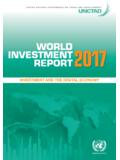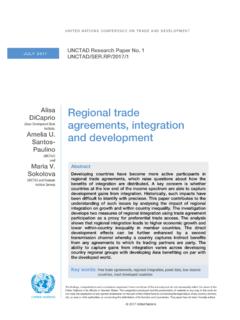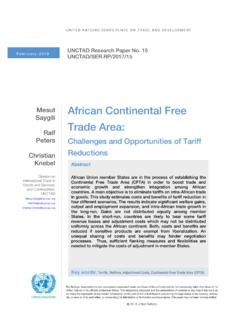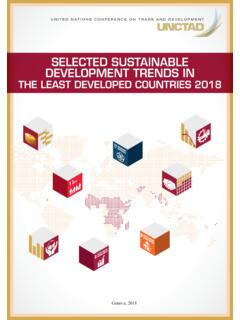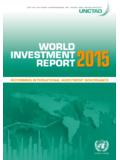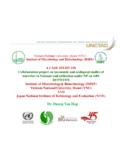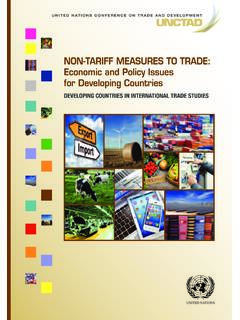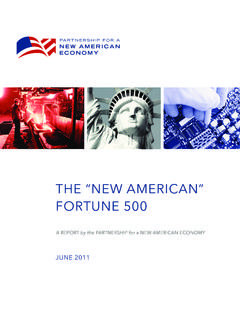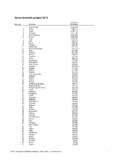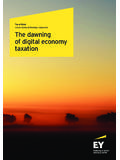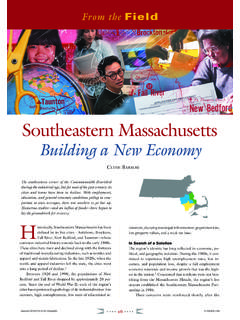Transcription of The New Digital Economy and Development - …
1 U n i t e d N at i o n s C o n f e r e n c e o n T r a d e A n d D e v e l o p m e n t THE NEW Digital Economy . AND Development . UNCTAD Technical Notes on ICT for Development N 8. UNCTAD, DIVISION ON TECHNOLOGY AND LOGISTICS. SCIENCE, TECHNOLOGY AND ICT BRANCH. ICT POLICY SECTION. TECHNICAL NOTE NO8 UNEDITED. TN/UNCTAD/ICT4D/08. OCTOBER 2017. The New' Digital Economy and Development1. Abstract: This technical note frames the New' Digital Economy (NDE) as including, most prominently: 1). advanced manufacturing, robotics and factory automation, 2) new sources of data from mobile and ubiquitous Internet connectivity, 3) cloud computing, 4) big data analytics, and 5) artificial intelligence.
2 The main driver of the NDE is the continued exponential improvement in the cost-performance of information and communications technology (ICT), mainly microelectronics, following Moore's Law. This is not new. The digitization of design, advanced manufacturing, robotics, communications, and distributed computer networking ( the Internet) have been altering innovation processes, the content of tasks, and the possibilities for the relocation of work for decades. However, three features of the NDE are relatively novel. First, new sources of data, from smart phones to factory sensors, are sending vast quantities of data into the cloud, where they can be analysed to generate new insights, products, and services.
3 Second, new business models based on technology and product platforms platform innovation, platform ownership, and platform complimenting . are significantly altering the organization of industries and the terms of competition in a range of leading-edge industries and product categories. Third, the performance of ICT hardware and software has advanced to the point where artificial intelligence and machine learning applications are proliferating. What these novel features share is reliance on very advanced and nearly ubiquitous ICT, embedded in a growing platform ecosystem characterized by high levels of interoperability and modularity.
4 The NDE appears poised to extend the organizational and geographical fragmentation of work into new realms, including formerly indivisible and geographically rooted activities that reside at the front end of global value chains, especially R&D, product design, and other knowledge-intensive and innovation-related business functions. The impact on jobs and international competition will crucially depend on the pace of change and the ability of organizations and societies to manage it. This technical note discusses how the NDE can be defined, explores its likely implications for the location of innovation and manufacturing, notably involving developing countries.
5 The likely implications for smaller and developing country firms are discussed, as are positive and negative scenarios for society in general. 1. This technical note was prepared by Dr. Timothy J. Sturgeon, from the MIT Industrial Performance Center with contributions and guidance from Torbj rn Fredriksson (team leader) and Diana Korka of UNCTAD. The note was commissioned by the ICT Policy Section of UNCTAD as background for the Information Economy Report 2017 (UNCTAD, 2017a). Useful feedback was provided by Judith Biewener, William Bonvillian, Masud Cader, Mark Dallas, Stefano Ponte, Marshall Van Alstyne, Hugh Whittaker, Ezequiel Zylberberg and participants in the Manufacturing activities and value creation: industry , global value chains, and circular Economy seminar held at dSEA, Universit degla Studi di Padova, Padova, Italy, May 4, 2017, and the The Digital Revolution and GVCs session at the Society for the Advancement of Socio-Economics 28th Annual Conference in Lyon, France, July 1 2017.
6 Financial contribution from the Government of Sweden is gratefully acknowledged for this project. TABLE OF CONTENTS. A. INTRODUCTION .. 1. B. WHAT IS THE NEW' Digital Economy ? .. 2. ADVANCED MANUFACTURING, ROBOTICS AND FACTORY AUTOMATION .. 3. NEW SOURCES OF DATA AND THE INTERNET OF THINGS .. 4. CLOUD COMPUTING .. 5. BIG DATA ANALYTICS .. 6. ARTIFICIAL 7. C. BUSINESS MODELS AND INDUSTRY ORGANIZATION IN THE NDE .. 8. THE IMPORTANCE OF PLATFORMS .. 8. OPEN INNOVATION, OPEN STANDARDS ..12. GLOBALIZATION AND MODULARITY ..14. D. THE NDE AND Development .. 16. MANUFACTURING IN THE NDE, WHAT ARE THE TRADE-OFFS? ..16. The geography of advanced 19.
7 INNOVATION IN THE NDE ..20. The geography of innovation in the NDE .. 22. LINKAGES BETWEEN MANUFACTURING AND INNOVATION IN THE SCENARIOS FOR DEVELOPING COUNTRIES IN THE NDE ..24. E. CONCLUDING REMARKS .. 26. WHAT'S NEW ABOUT THE NDE? ..26. WINNERS AND LOSERS, OPPORTUNITIES AND RISKS ..27. DATA PARTITIONING, A NEW Digital DIVIDE? ..29. REFERENCES .. 31. ii A. Introduction Change is in the air. Recent public debate has become focused, with increasing frequency and urgency, on the imminent arrival of a 4th Industrial Revolution which is said to be creating a new . Digital Economy (NDE) powered by advanced cyber-physical systems spanning advanced.
8 Manufacturing, transportation, services, and even biological systems (Rose, 2016; Schwab, 2015, 2017). This technical note adopts the term NDE to frame a set of technologies and processes that most prominently include: 1) advanced production equipment, robotics and factory automation, 2). new sources of data from mobile and ubiquitous Internet connectivity, 3) cloud computing, 4) big data analytics, and 5) artificial intelligence. These technologies and processes are mainly based, in one way or another, on advanced information and communications technology (ICT). They seem poised to dramatically reduce demand for routine tasks and transform the location, organization, and content of knowledge work.
9 Broad policy questions include: Who will build the systems underpinning the NDE? Where in the world will the NDE emerge, and when? How will the NDE alter the demand for labour and skills? When and to what degree will the NDE alter the balance of power and incomes within and across industries and societies? Will the NDE introduce unacceptable privacy concerns and cyber-security risk, or will such risks and concerns be manageable and outweighed by benefits to users? Where the infrastructure of the NDE is built and deployed, and how its benefits and risks are distributed geographically and across societies, have implications for developing countries, places that are often lagging in terms of technology adoption as it is (UNCTAD, 2017a).
10 Will the NDE reinforce patterns of uneven Development or provide a more level playing field for less developed firms, communities, regions and countries? Will the emerging platform ecosystems of the NDE further concentrate wealth and market power in a few technology clusters where core platform owners are located, relegating places that mainly use and create complements for platforms to a dependent status, or can technology platforms provide lagging firms the tools needed to move out of lower value added segments of global value chains (GVCs) and develop innovative products of their own? While it is too early to answer these questions, on balance, this technical note places these questions in context by introducing a series of concrete examples of how the NDE is developing, and explores various scenarios related to the location of production and innovation.
